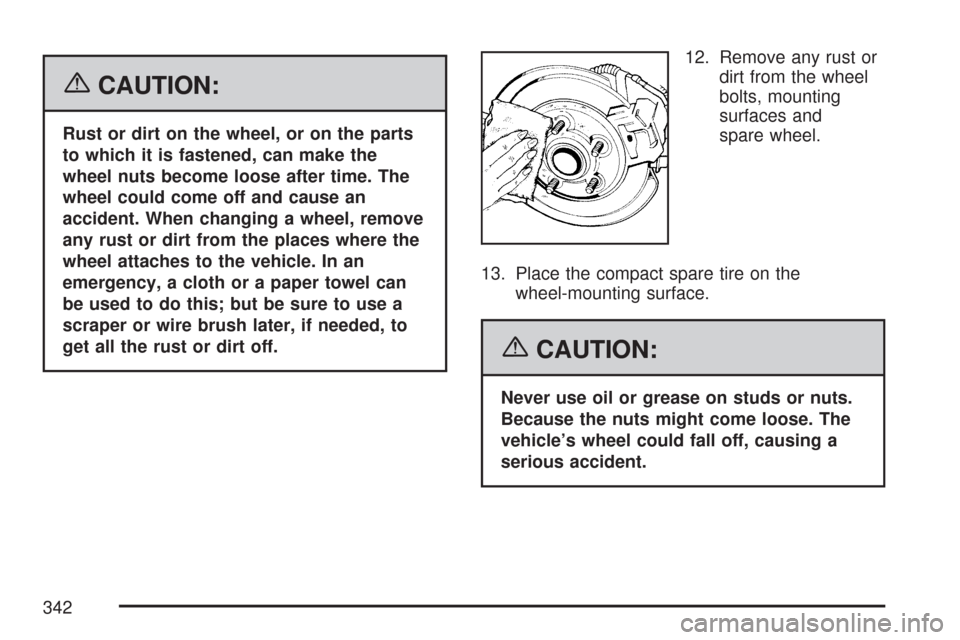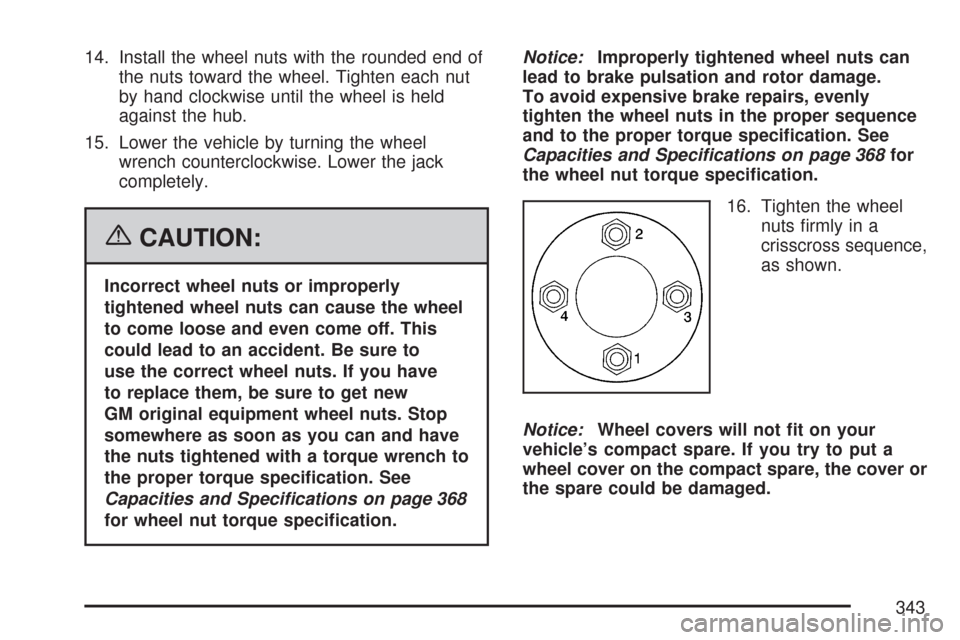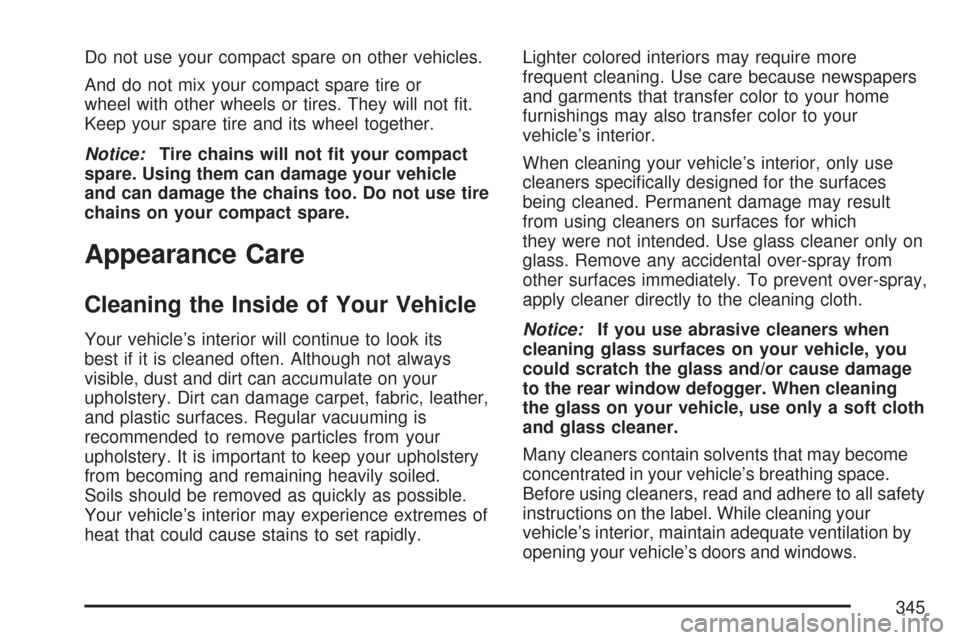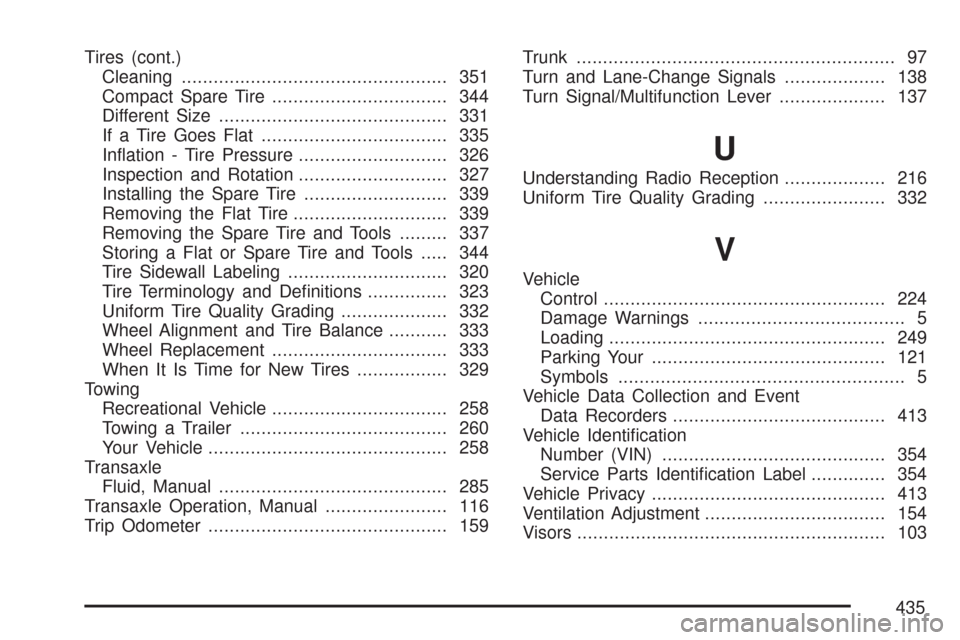2007 CHEVROLET AVEO spare wheel
[x] Cancel search: spare wheelPage 342 of 436

{CAUTION:
Rust or dirt on the wheel, or on the parts
to which it is fastened, can make the
wheel nuts become loose after time. The
wheel could come off and cause an
accident. When changing a wheel, remove
any rust or dirt from the places where the
wheel attaches to the vehicle. In an
emergency, a cloth or a paper towel can
be used to do this; but be sure to use a
scraper or wire brush later, if needed, to
get all the rust or dirt off.12. Remove any rust or
dirt from the wheel
bolts, mounting
surfaces and
spare wheel.
13. Place the compact spare tire on the
wheel-mounting surface.
{CAUTION:
Never use oil or grease on studs or nuts.
Because the nuts might come loose. The
vehicle’s wheel could fall off, causing a
serious accident.
342
Page 343 of 436

14. Install the wheel nuts with the rounded end of
the nuts toward the wheel. Tighten each nut
by hand clockwise until the wheel is held
against the hub.
15. Lower the vehicle by turning the wheel
wrench counterclockwise. Lower the jack
completely.
{CAUTION:
Incorrect wheel nuts or improperly
tightened wheel nuts can cause the wheel
to come loose and even come off. This
could lead to an accident. Be sure to
use the correct wheel nuts. If you have
to replace them, be sure to get new
GM original equipment wheel nuts. Stop
somewhere as soon as you can and have
the nuts tightened with a torque wrench to
the proper torque speci�cation. See
Capacities and Specifications on page 368
for wheel nut torque speci�cation.Notice:Improperly tightened wheel nuts can
lead to brake pulsation and rotor damage.
To avoid expensive brake repairs, evenly
tighten the wheel nuts in the proper sequence
and to the proper torque speci�cation. See
Capacities and Specifications on page 368for
the wheel nut torque speci�cation.
16. Tighten the wheel
nuts firmly in a
crisscross sequence,
as shown.
Notice:Wheel covers will not �t on your
vehicle’s compact spare. If you try to put a
wheel cover on the compact spare, the cover or
the spare could be damaged.
343
Page 344 of 436

Storing a Flat or Spare Tire
and Tools
{CAUTION:
Storing a jack, a tire, or other equipment
in the passenger compartment of the
vehicle could cause injury. In a sudden
stop or collision, loose equipment could
strike someone. Store all these in the
proper place.
To store a flat or compact spare tire and tools, do
the following:
1. Store the flat tire or the compact spare in the
compact spare tire compartment.
2. Secure the retainer.
3. Store the tools securely in the foam tray and
place the tray back in the cargo area.
4. Replace the trim cover.
The compact spare tire is for temporary use only.
Replace the compact spare tire with a full-size
tire as soon as you can. SeeCompact Spare Tire
on page 344.
Compact Spare Tire
Although the compact spare tire was fully inflated
when your vehicle was new, it can lose air
after a time. Check the inflation pressure regularly.
It should be 60 psi (420 kPa).
After installing the compact spare on your vehicle,
you should stop as soon as possible and make
sure your spare tire is correctly inflated. The
compact spare is made to perform well at speeds
up to 50 mph (80 km/h), so you can finish your
trip and have your full-size tire repaired or replaced
where you want. Of course, it is best to replace
your spare with a full-size tire as soon as you can.
Your spare will last longer and be in good shape
in case you need it again.
Notice:When the compact spare is installed,
do not take your vehicle through an automatic
car wash with guide rails. The compact
spare can get caught on the rails. That can
damage the tire and wheel, and maybe
other parts of your vehicle.
344
Page 345 of 436

Do not use your compact spare on other vehicles.
And do not mix your compact spare tire or
wheel with other wheels or tires. They will not fit.
Keep your spare tire and its wheel together.
Notice:Tire chains will not �t your compact
spare. Using them can damage your vehicle
and can damage the chains too. Do not use tire
chains on your compact spare.
Appearance Care
Cleaning the Inside of Your Vehicle
Your vehicle’s interior will continue to look its
best if it is cleaned often. Although not always
visible, dust and dirt can accumulate on your
upholstery. Dirt can damage carpet, fabric, leather,
and plastic surfaces. Regular vacuuming is
recommended to remove particles from your
upholstery. It is important to keep your upholstery
from becoming and remaining heavily soiled.
Soils should be removed as quickly as possible.
Your vehicle’s interior may experience extremes of
heat that could cause stains to set rapidly.Lighter colored interiors may require more
frequent cleaning. Use care because newspapers
and garments that transfer color to your home
furnishings may also transfer color to your
vehicle’s interior.
When cleaning your vehicle’s interior, only use
cleaners specifically designed for the surfaces
being cleaned. Permanent damage may result
from using cleaners on surfaces for which
they were not intended. Use glass cleaner only on
glass. Remove any accidental over-spray from
other surfaces immediately. To prevent over-spray,
apply cleaner directly to the cleaning cloth.
Notice:If you use abrasive cleaners when
cleaning glass surfaces on your vehicle, you
could scratch the glass and/or cause damage
to the rear window defogger. When cleaning
the glass on your vehicle, use only a soft cloth
and glass cleaner.
Many cleaners contain solvents that may become
concentrated in your vehicle’s breathing space.
Before using cleaners, read and adhere to all safety
instructions on the label. While cleaning your
vehicle’s interior, maintain adequate ventilation by
opening your vehicle’s doors and windows.
345
Page 434 of 436

Service (cont.)
California Proposition 65 Warning............. 265
Doing Your Own Work............................. 265
Engine Soon Light...........................166, 180
Publications Ordering Information............. 420
Servicing Your Airbag-Equipped Vehicle......... 82
Sheet Metal Damage................................... 351
Shifting Into Park (P)................................... 118
Shifting Out of Park (P)............................... 120
Short Trip/City Scheduled Maintenance........ 376
Shoulder Belt Height Adjuster........................ 33
Signals, Turn and Lane-Change.................. 138
Spare Tire
Compact.................................................. 344
Installing.................................................. 339
Removing................................................ 337
Storing..................................................... 344
Specifications, Capacities............................ 368
Speedometer............................................... 159
Starting Your Engine................................... 109
Steering...................................................... 228
Steering, Suspension and Front Drive
Axle Boot and Seal Inspection................. 394
Steering Wheel Controls, Audio................... 215
Steering Wheel, Tilt Wheel.......................... 136Storage Areas............................................. 126
Cupholder(s)............................................ 127
Glove Box................................................ 127
Sunglasses Storage Compartment............ 127
Stuck in Sand, Mud, Ice, or Snow............... 248
Sun Visors.................................................. 103
Sunroof....................................................... 128
T
Tachometer................................................. 159
Taillamps
Turn Signal, Stoplamps and Back-up
Lamps.................................................. 316
Theft-Deterrent System................................ 103
Theft-Deterrent Systems.............................. 103
Immobilizer.............................................. 106
Immobilizer Operation.............................. 106
Tilt Wheel.................................................... 136
Time ........................................................... 149
Tires........................................................... 319
Aluminum Wheels, Cleaning..................... 350
Buying New Tires..................................... 330
Chains..................................................... 335
Changing a Flat Tire................................ 336
434
Page 435 of 436

Tires (cont.)
Cleaning.................................................. 351
Compact Spare Tire................................. 344
Different Size........................................... 331
If a Tire Goes Flat................................... 335
Inflation - Tire Pressure............................ 326
Inspection and Rotation............................ 327
Installing the Spare Tire........................... 339
Removing the Flat Tire............................. 339
Removing the Spare Tire and Tools......... 337
Storing a Flat or Spare Tire and Tools..... 344
Tire Sidewall Labeling.............................. 320
Tire Terminology and Definitions............... 323
Uniform Tire Quality Grading.................... 332
Wheel Alignment and Tire Balance........... 333
Wheel Replacement................................. 333
When It Is Time for New Tires................. 329
Towing
Recreational Vehicle................................. 258
Towing a Trailer....................................... 260
Your Vehicle............................................. 258
Transaxle
Fluid, Manual........................................... 285
Transaxle Operation, Manual....................... 116
Trip Odometer............................................. 159Trunk............................................................ 97
Turn and Lane-Change Signals................... 138
Turn Signal/Multifunction Lever.................... 137
U
Understanding Radio Reception................... 216
Uniform Tire Quality Grading....................... 332
V
Vehicle
Control..................................................... 224
Damage Warnings....................................... 5
Loading.................................................... 249
Parking Your............................................ 121
Symbols...................................................... 5
Vehicle Data Collection and Event
Data Recorders........................................ 413
Vehicle Identification
Number (VIN).......................................... 354
Service Parts Identification Label.............. 354
Vehicle Privacy............................................ 413
Ventilation Adjustment.................................. 154
Visors.......................................................... 103
435